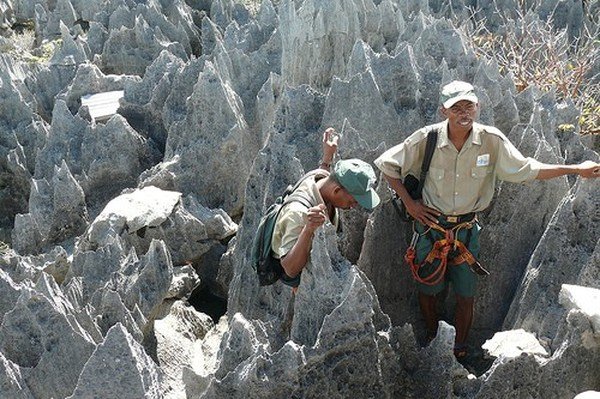|
|
Stone Forest In Madagascar, Manambulu - Bemaraha
|
The first transcription of Malagasy using Arabic script (sorabe) and certain elements of Malagasy cosmology were introduced ca 1500 by Arabs, and islamised Indians and Indonesian people who were established on the Southeast coast (in the current Vohipeno and Manakara region).
Malagasy, the Austronesian language spoken in various forms by the vast majority of the population, is the national language and one of two current official languages alongside French and English. The majority of the population adheres to traditional beliefs or Christianity, but followers of other faiths such as Islam and Hinduism are found in smaller numbers throughout the country.
Until the late 18th century, the island of Madagascar was populated by a fragmented assortment of shifting socio-political alliances of varying sizes. Beginning in the early 19th century, however, the majority of the island was united and ruled as the Kingdom of Madagascar by a series of nobles (andriana) of the Merina ethnic group. The monarchy collapsed when the island was conquered and absorbed into the French colonial empire in 1896, from which the island gained independence in 1960. The autonomous state of Madagascar has since undergone four major constitutional periods, including a post-colonial First Republic under President Philibert Tsiranana (1960–1972), a Soviet-style socialist Second Republic under Admiral Didier Ratsiraka (1975–1991), and a democratic Third Republic under successive presidents Albert Zafy, Didier Ratsiraka and Marc Ravalomanana (1992–2009). Since 1992 the nation has officially been governed as a constitutional democracy from its capital at Antananarivo by an elected president who serves a renewable five-year term and is supported by the prime minister he or she nominates. However, following a popular uprising in 2009 instigated by then-mayor of Antananarivo and TGV political party president Andry Rajoelina, Ravalomanana was pressured to resign. Presidential power was then unconstitutionally transferred to Rajoelina with the support of a portion of the military. A 2010 constitutional referendum ushered in the Fourth Republic in which the nation continues to be managed by Rajoelina's unelected caretaker government known as the High Transitional Authority (HAT). Rajoelina (b. 1974), currently the youngest head of state in Africa, has failed to secure recognition from the international community, which largely views the current administration as illegitimate and has widely characterized Rajoelina's seizure of power as a coup d'état.
In 2010, the population of Madagascar was estimated at around 20 million, 85% of whom live on less than two dollars per day. Ecotourism, agriculture, expansion of international trade and greater investments in education, health and private enterprise are key elements of Madagascar's development strategy. Under Ravalomanana, these investments produced substantive economic growth but the benefits were not evenly spread throughout the population, producing tensions over the increasing cost of living and declining living standards among the poor and some segments of the middle class. Current and future generations in Madagascar are faced with the challenge of striking a balance between economic growth, equitable development and natural conservation.
|
|









